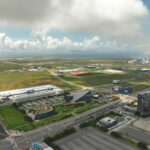ASIA ELECTRONICS INDUSTRYYOUR WINDOW TO SMART MANUFACTURING
LG Chem Begins Construction of New CNT Plant in Korea
LG Chem has started construction of its fourth carbon nanotube (CNT) plant at its Daesan Complex, 80 kilometers southwest of Seoul. Specifically, LG Chem’s CNT 4 Plant is slated for operation in 2025. It will contribute to doubling LG Chem’s annual CNT production capability to 6,100 tons.
Recently, LG Chem’s 1,200-tons CNT 3 Plant in Yeosu was recently put into full operation. CNT 3 Plant enabled LG Chem to secure a total production of 2,900 tons/year. This scale is on top of the existing 1,700 tons it produces annually.
LG Chem continuously expands its CNT production capacity to gain a strong competitive advantage in the global CNT market, which is rapidly evolving around electric vehicle (EV) battery materials. Moreover, LG Chem has been operating CNT plants since 2017 starting from 500-ton productions at its CNT Plant 1. Since 2020, it has been building new plants every year to meet growing demands.

Thanks to the company’s fluidized bed reactor technology, production lines at all four LG Chem’s CNT plants produce up to 600 tons on a yearly basis. This demonstrates the highest single-line capacity in the world.
“With the nation’s largest CNT production capacity, we will continue building a strong competitive advantage in the battery materials sector and actively explore new business opportunities by moving faster than our competitors,” said Noh Kug-lae, President of LG Chem’s Petrochemical Business.
Expand Usage to Broader Industries
LG Chem will supply the produced CNT materials as conductive additives to battery makers including the current global EV battery market leader LG Energy Solution. Accordingly, the company plans to expand its usage to a broader range of industries. When used as conductive additives for cathodes, CNT reduces the volume of conductive additives in batteries by nearly 30 percent while achieving 10 percent more conductivity than carbon black. CNT-based batteries deliver higher capacity and longer lifespan as more power-generating cathode materials can be used in place of the conductive additives. Thus, besides conductive additives for cathodes, CNT is also an attractive conductive additive of next-generation anode, lithium sulfur and solid-state batteries.
That said, LG Chem is actively stretching out its CNT sales to various sectors besides EV batteries. LG Chem has recently started supplying CNT-added, metal-replacing electrostatic coating plastics to Japanese automaker Mitsubishi Motors, which is now applying the material to the front fenders of its three vehicle models. Furthermore, this plastic can be varied and customized to make other types of automotive parts such as bumper panels, hoods, tailgates, fuel doors, and side mirrors.
Also, LG Chem is supplying CNT to a Korean automotive maker. This allows the company to apply the material to its radar-absorbing system for electromagnetic interference (EMI) purposes.
Generally, CNT is a next-generation material offering the equivalent level of electricity and thermal conductivity as copper and diamond and 100 times the strength of steel. Due to its excellent properties that surpass existing materials, CNT has an infinite range of applications in batteries, semiconductors, automotive components, and surface heating elements. The global CNT conductive additive market is expected to grow to US$2.3 billion contributing to the total demand of CNT increasing from 14,000 tons in 2022 to 95,000 tons by 2030.
LG Chem has been focusing on the CNT sector since 2011 when it started researching and developing its own CNT technology. In 2013, LG Chem successfully built a 20-ton pilot line for CNTs and developed CNT-based products for conductive compounds and batteries in the following year. LG Chem is also a holder of more than 300 patents in the CNT field to date.




